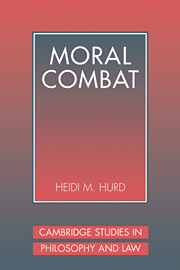Book contents
- Frontmatter
- Contents
- Preface
- Acknowledgments
- Part I The Dilemma of Legal Perspectivalism
- Part II Sources of the Dilemma of Legal Perspectivalism
- Part III The Moral Case for Legal Perspectivalism
- Part IV The Moral Case Against Legal Perspectivalism
- 10 Consequentialism and Moral Correspondence
- 11 Deontology and Moral Correspondence
- Part V Resolving the Dilemma of Legal Perspectivalism
- Bibliography
- Index
11 - Deontology and Moral Correspondence
Published online by Cambridge University Press: 05 November 2011
- Frontmatter
- Contents
- Preface
- Acknowledgments
- Part I The Dilemma of Legal Perspectivalism
- Part II Sources of the Dilemma of Legal Perspectivalism
- Part III The Moral Case for Legal Perspectivalism
- Part IV The Moral Case Against Legal Perspectivalism
- 10 Consequentialism and Moral Correspondence
- 11 Deontology and Moral Correspondence
- Part V Resolving the Dilemma of Legal Perspectivalism
- Bibliography
- Index
Summary
Recall that deontologists deny the consequentialist's claim that the Tightness of an act consists in its maximization of good consequences. They locate the goodness of an act, not in its consequences, but in the act itself. According to a deontological theory, some act-types are intrinsically right while others are intrinsically wrong. Moral action consists in complying with agent-relative maxims that categorically prohibit or require the performance of certain acts. Individuals do not act rightly in violating the conditions of right action so as to maximize the instances in which they or others act rightly. If it is wrong to kill the innocent, then an agent is prohibited from killing an innocent person even if, by so doing, he prevents another agent from killing many innocent persons in violation of the agent-relative prohibition directed at her. If it is right to tell the truth, then an actor does wrong to lie, even if the lie will bring about substantially more truth-telling by others. And if it is wrong to punish persons who nonculpably do the right thing, then it is wrong to punish the justified even if in so doing one will dramatically reduce the instances in which the justified are punished.
In Chapter 1, I suggested that any plausible deontological theory would comply with the correspondence thesis, at least when construed in its original form as a thesis about the conditions of preventative and permissive actions. But this is not because the thesis in its original form is, as a conceptual matter, necessarily true of deontology.
- Type
- Chapter
- Information
- Moral CombatThe Dilemma of Legal Perspectivalism, pp. 271 - 294Publisher: Cambridge University PressPrint publication year: 1999



